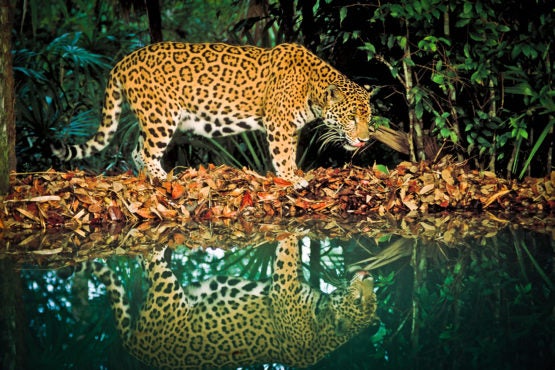October 15, 2020
Stanford researchers help Belize plan for sustainable, nature-based development to create more economic resilience amid global pandemic
Drawing on research by Stanford scientists, countries like Belize are finding new ways to supplement their devastated ecotourism-driven economies during the COVID-19 pandemic.
Before COVID-19 struck, Belize was a popular tourist destination for ziplining, scuba diving and glimpsing jaguars in their natural jungle habitat.

Belize’s biodiversity has made it into a top ecotourism destination. The country’s new sustainable development plan will protect animals like the jaguar while providing livelihood opportunities for the local community. (Image credit: Tony Rath Photography / tonyrath.com)
But with a global pandemic keeping international travelers away, its ecotourism-driven economy is in trouble.
To prevent even more economic fallout, the country launched an ambitious plan this month based on research from the Stanford Natural Capital Project to jumpstart its economy by investing in its ecosystems.
“This is about creating a resilient economy that values and protects the natural resources that sustain it,” said Adrian Vogl, lead scientist at the Stanford Natural Capital Project and team lead for the technical development of the plan. “Belize is a world leader in using a science- and data-driven approach to incorporate the benefits from ecosystems into their sustainable development planning.”
The researchers used open-source mapping software to pinpoint the benefits that Belize’s people and economy draw from the country’s Chiquibul-Mountain Pine Ridge-Caracol Complex natural area, such as its biodiverse forests and rivers, clean water and food production. They also helped the government account for the economic gains that ecosystems provide and track how those gains might change depending on how they choose to develop an area.
The rich rainforests and Mayan ruins of the region normally pump more than $15 million USD each year from 13 tourism sites and 27 resorts. When tourism collapsed due to the COVID-19 pandemic, the researchers and the Office of the Prime Minister’s sustainable development team realized Belize could no longer depend on it as an economic driver.
Fortunately, the team had spent over a year engaging with community members from businesses, agriculture, non-governmental organizations and government to better understand the ways local people rely on the natural area. They concluded that, in addition to tourism and recreation opportunities, the region provides drinking water to one-third of all Belizeans. For the local community, it is a source of timber for building, food like corn and beans, and traditional medicinal plants. It’s also a place to celebrate their Mayan cultural heritage by growing and harvesting the crops of their ancestors
Combining local feedback with technical maps from the Natural Capital Project-developed InVEST software, the Stanford researchers created recommendations to support people’s economic needs while protecting critical ecosystems. These activities include sustainable forestry and agriculture, protection of water sources and an increased focus on domestic, rather than international, tourism.
Developing the tourism market for other Belizeans was an important part of creating a more resilient plan. The Mayan cultural sites and ecotourism activities have the potential to attract Belizeans, but until now the government’s tourism board has spent more time focused on the international market. A new market of Belizean visitors could leverage current ecotourism infrastructure while buffering against the volatility of international tourism.
The researchers also see similar opportunities for other countries whose ecotourism industries have been hard-hit by COVID-19 to rethink their economies. They emphasize that one natural area can provide a diversity of benefits to the economy. By using tools like InVEST, government planners can make choices that protect natural benefits and create stable footing for their economy.
With the region’s Sustainable Development Plan in hand, and with airports recently open to tourists again, the Office of the Prime Minister says it’s now more prepared to develop sustainably.
“This bold and innovative master plan offers us the opportunity for Belize to pioneer a landscape management approach to its protected areas, setting a notable example for our region and beyond,” said Prime Minister Dean Oliver Barrow. “I have every confidence that together we will achieve economic development while protecting our rich biodiversity for the wellbeing of generations to come.”
The Sustainable Development Plan process was led by Belize’s Office of the Prime Minister and Economic Development Council with support from the Inter-American Development Bank and Stanford’s Natural Capital Project. The University of Belize Environmental Research Institute also provided technical support.
-30-
|